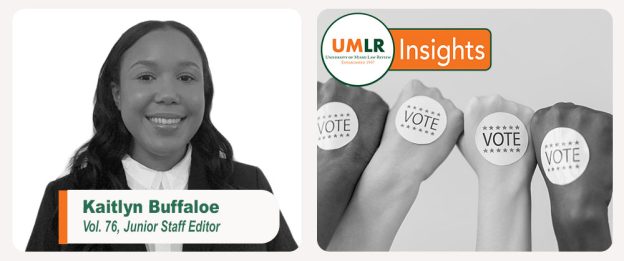KAITLYN BUFFALOE—In early February, the Supreme Court granted Alabama’s bid to temporarily halt the U.S. District Court for the Northern District of Alabama’s ruling that required the state to redraw its new congressional map to comply with Section 2 of the Voting Rights Act. The lower court found that Alabama’s congressional map diluted the power of Black voters because African Americans, who account for 27 percent of Alabama residents, only constituted a majority in one of its seven congressional districts. Further, the lower court stressed that its decision to grant a preliminary injunction “rests on an extremely robust body of evidence” created by live testimony from seventeen expert witnesses and over 2,000 pages of briefing. Alabama officials appealed to the Supreme Court for an emergency stay following the lower court’s order. The state officials argued that the order will cause “massive disruption” of the state’s elections and “is premised on the noxious idea that redistricting begins and ends with racial consideration.”
In granting the emergency stay, the Supreme Court majority seemingly privileged the convenience of state legislators over the ability of Black voters to secure the fair representation required under the Voting Rights Act. Justice Brett Kavanaugh’s concurring opinion relied on the Purcell principleto support the idea that federal courts should not re-do a state’s election laws in the period close to an election. The Purcell principle “reflects a bedrock tenet of election law: When an election is close at hand, the rules of the road must be clear and settled.” Accordingly, if the Court mandated compliance with the district court’s order, it would require “heroic efforts” by election officials and, even still, “likely would not be enough to avoid chaos and confusion.” Thus, Justice Kavanaugh underscored that the stay order was a simple matter of maintaining regular judicial process and would allow the Court to decide on the merits in the fall.
However, Justice Elena Kagan, joined by Justices Stephen Breyer and Sonia Sotomayor, sharply disagreed with his concurring opinion. Regarding the Purcell principle, she noted that the lower court had acted well before the next primary election, in late May, and the general election, in November. Further, even if the timing were a concern, it only took the Republican-controlled Alabama Legislature a “mere five days” to draw a new map following the 2020 census data, which reflected an increase in Alabama’s Black population. Therefore, in her view, the district court’s order seems unlikely to cause the mass confusion that the Purcell precedent seeks to avoid. Further, Justice Kagan asserted that “Alabama is not entitled to keep violating Black Alabamians’ voting rights just because the court’s order came down in the first month of an election year.” Ultimately, she warned that accepting Alabama’s contention would, in effect, rewrite decades of precedent about Section 2 of the Voting Rights Act.
In a separate dissent, Chief Justice Roberts took a more practical approach. He agreed with Justice Kagan that the lower court had properly applied existing law “with no apparent errors for our correction.” Yet, he highlighted the considerable uncertainty in Supreme Court precedent surrounding the “nature and contours of a vote dilution claim.” Given the influx of uncertainty, the Chief Justices’ preferred solution would have been for the 2022 election to be governed by the lower court’s order but for subsequent elections to be governed by the Supreme Court’s review in the fall.
So, what does this mean for the future of the Voting Rights Act and upcoming elections in 2022? Notably, the dispute in Alabama is not unique as numerous redistricting battles are playing out across the country, with Democrats and Republicans challenging electoral districts as illegal gerrymanders. However, the Court’s order indicates that the role of race in drawing voting districts may significantly change and could lead to the implementation of a new standard for such claims. Moreover, the Court’s Voting Rights Act precedent demonstrates its willingness to narrow the scope and breadth of the statute. Perhaps the most famous example is Shelby County v. Holder, where the Court substantially limited the once-powerful Section 5 provision of the Voting Rights Act. In Shelby County, the Court overturned the prerequisite requiring states with a history of race-based voting discrimination to obtain preapproval that its procedures were not discriminatory. Even more recently, the Court’s decision in Brnovich v. Democratic National Committee also displays the systemic reduction of the Voting Rights Act. In Brnovich, the Court made it harder for plaintiffs to bring Section 2 claims by delineating a new five-factor test that included substantial deference “to the strength of the state’s justification, particularly when the state asserts voter fraud as a justification.” Such factors protect the states against many Section 2 lawsuits and make it harder for plaintiffs to challenge discriminatory laws. Justice Kagan even wrote in her dissenting opinion that “the Court has (yet again) rewritten—in order to weaken—a statute that stands as a monument to America’s greatness, and protects against its basest impulses.” Accordingly, Voting Rights Act precedent reveals that the new approach adopted by the Court may give greater deference to states and, consequently, limit constitutional challenges to restrictive voting laws.
Ultimately, while the Court’s order preserves Section 2 as a means to challenge discriminatory voting restrictions, the future of Section 2 vote dilution claims remains uncertain. With the conservative majority that continues to control the Court, the effective parts of the Voting Rights Act that remain may be on borrowed time. Nonetheless, it is imperative for the Court—or Congress—to protect the rights of marginalized voters and restore the efficacy of the Voting Rights Act.






